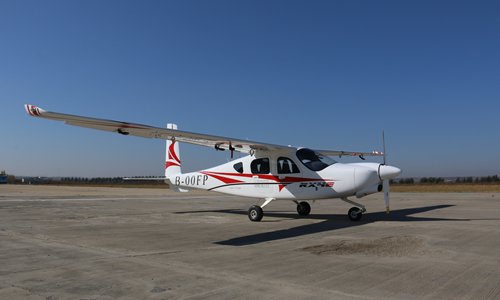HOME >> BUSINESS
China’s first four-seat electric aircraft makes maiden flight
By Wang Bozun Source:Global Times Published: 2019/10/29 13:49:28
After successful test of RX4E, industry urges support from nation's regulators

A general view of the Liaoning General Aviation Academy (LGAA) developed electric aircraft RX4E Photo: Courtesy of LGAA
A test of China's first domestic four-seat new-energy aircraft was held successfully on Monday, drawing praise from industry insiders and analysts who said that while the plane represents a breakthrough, there's a need for technological improvement and strong regulatory support.
The RX4E, a general aviation product developed by Liaoning General Aviation Academy (LGAA), made its maiden flight from the Cai Hu airport near Shenyang, Northeast China's Liaoning Province.
"It is a breakthrough in China's electric aircraft development," Wang Yanan, chief editor of Aerospace Knowledge magazine, told the Global Times. Wang said that the test represents a good start for China amid a global trend of electric aircraft development.
According to documents provided by LGAA to the Global Times, the RX4E measures 13.5 meters in length and 8.4 meters in depth, with a takeoff weight of 1,200 kilograms, a maximum power of 140 kilowatts, a cruising speed of 200 kilometers per hour, and a flying time of 90 minutes. Carbon fiber composite materials are widely used in the aircraft structure, and they account for 77 percent of the total structural weight of the plane.
The total installed capacity of the system's power battery is nearly 70 kilohertz. The plane has adopted the first cell product whose energy density exceeds 300 watt-hours per kilogram in China, which is at the leading level globally, according to the documents.
As it has the ability to take off and land on hard grass or sand, stone pavements and coastal airports, the market potential of the RX4E is huge, LGAA employees told the Global Times. They said the plane could be used for short-distance transportation, pilot training, sightseeing, experience flight, aerial photography and aerial mapping, and other fields.
"The successful maiden flight of the RX4E is a significant step for China," Ma Yuzhong, an industry watcher, told the Global Times.
But, as other countries expedite development in this field, experts and industrial insiders warned that China must speed up.
The successful development of the RX4E has created a national brand with independent intellectual property rights, the LGAA employees said. However, as many countries are expediting the development of electric aircraft, the LGAA is urging regulators in China to speed up the release of a clearer roadmap.
According to data provided by the LGAA, as of June this year, there were more than 170 projects involving electric aircraft, and the number is expected to exceed 200 by the end of this year.
"Advanced aviation bodies, such as NASA, Boeing and AIRBUS, have put forward clear research and development plans for electric aircraft, and foreign governments are supporting and promoting them," the documents said, urging more support from the government.
Wang agreed with the LGAA's idea, saying that, despite the successful test, there are still technical problems to be solved before these aircraft enter commercial service. Regulators should provide strong support to industry players in research and development in this new sector.
Wang noted that due to a bottleneck in developing batteries, industry players worldwide are more or less at the same level, so "anyone who wants to take leading position in the industry now must make technological breakthroughs. It is a big challenge that also requires regulators' support."
Newspaper headline: Pioneering electric aircraft flies high